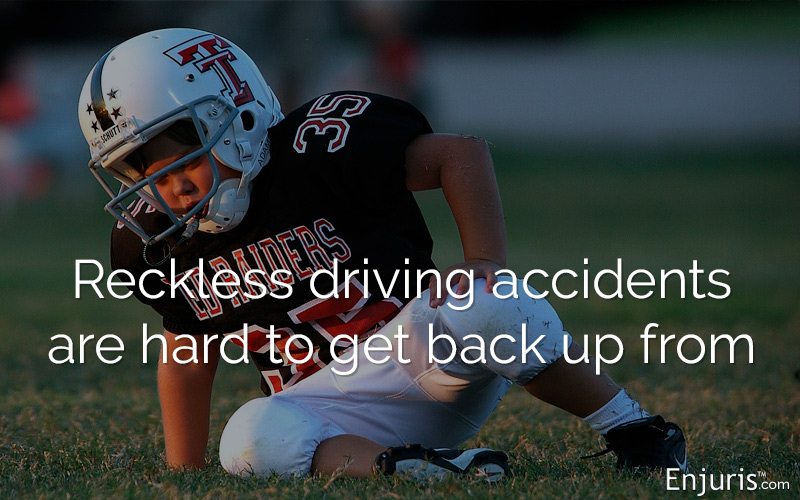Hablamos español.
Reckless driving accidents are treated differently than other types of car accidents
There’s a lot to like about the state of Texas, including live music, sandy beaches, and a state-of-the-art space center. But, Texas has a dark secret...
Texas is one of the most dangerous places to drive in the entire country.
Skeptical? Just take a look at the following statistics based on 2017 data:
- 1 person is killed in a car accident in Texas every 2 hours and 21 minutes
- 1 person is injured in a car accident in Texas every 2 minutes and 4 seconds
- 1 reportable crash occurs in Texas every 59 seconds
There are lots of reasons why Texas is such a dangerous place to drive, but one of the more worrisome reasons is the prevalence of reckless driving.
What is reckless driving?
According to Section 545.401 of the Texas Transportation Code, a person commits the offense of reckless driving if the person:
“drives a vehicle in willful or wanton disregard for the safety of persons or property.”
Willful? Wanton?
What exactly does this all mean?
The first thing to understand is that reckless driving requires more than mere negligence. It’s not enough that the driver was careless, rather the driver must understand that their action is likely to cause substantial harm and do it anyway.
To put it another way, willful or wanton behavior comes very close to actual intent to cause harm.
Let’s look at a couple of examples:
Reckless driving example 1
Lamar just received his driver’s license last month. He decides to take his first trip as a licensed driver to the grocery store in El Paso. On his way, Lamar follows the pickup truck in front of him a little too closely and when the driver of the pickup slams on his brakes to avoid hitting a dog, Lamar rear-ends the pickup truck.
In this hypothetical, Lamar drove carelessly because he was following the pickup too closely. Accordingly, Lamar is almost certainly negligent. However, Lamar didn’t intend to cause harm and he probably wasn’t aware that his actions were likely to cause substantial harm.
As a result, he’s probably not guilty of reckless driving.
Reckless driving example 2
Kelly is late for soccer practice at Western Texas College. Because she's running late, she drives down Round Top Road at 120 miles per hour while texting her coach that she’s on her way. Approaching a stop sign, Kelly decides to take her chances and blow through it. She collides with another vehicle crossing the intersection.
In this hypothetical, Kelly certainly understood that driving 120 miles per hour and running a stop sign was likely to cause substantial harm, but she did it anyway.
As a result, Kelly is probably guilty of reckless driving.
Other examples of behavior that might rise to the level of reckless driving include:
- Speeding
- Running stop signs or red lights
- Failing to yield the right of way
- Driving while intoxicated
- Racing with other vehicles
- Evading law enforcement
- Texting while driving (and other distracted driving behaviors)
- Passing a stopped school bus
Are there penalties for reckless driving?
In Texas, reckless driving is a crime. More specifically, reckless driving is a misdemeanor punishable by:
- A fine not to exceed $200,
- Confinement in a county jail for not more than 30 days, or
- Both a fine and confinement in jail.
The punishment for reckless driving might not seem severe and, in fact, Texas is considered one of the most lenient states for reckless driving. However, it’s important to keep in mind that, depending on the circumstances, a reckless driver may be charged with additional violations, including:
- Hit-and-run
- Speeding
- Street racing
- Driving while intoxicated
Each of these charges can carry additional penalties, including significant fees and jail time.
How does reckless driving impact a personal injury lawsuit?
In most car accident cases, you need to prove that the other driver was negligent to receive compensation. This means you have to prove the following elements:
- The driver owed you a duty to drive with a reasonable degree of care
- The driver breached their duty by failing to drive with a reasonable degree of care under the circumstances
- The driver’s breach was the cause of your damages
However, if the other driver received a ticket for reckless driving, your job becomes a lot easier. That’s because negligence per se applies in cases where a person violates a law that’s intended to protect the public.
Because negligence per se applies to reckless driving cases, you don’t have to worry about proving all the elements of negligence. Instead, you only need to prove the following to receive compensation for your injuries:
- The defendant violated the law (i.e., the defendant was reckless)
- The intent of the law was the prevention of the injury that ended up occurring, and
- The injured person is counted in the class of people the law was intended to protect.
The last 2 elements above sound more complicated than they really are. Basically, if you suffered an injury in a car accident as a driver, passenger, or pedestrian, you satisfy the last 2 elements.
Compensation in a reckless driving case
If you’re injured in a car accident in which the other driver was reckless, you can receive both economic and non-economic damages.
| Economic Damages | Non-economic Damages |
|---|---|
| Medical expenses | Pain and suffering |
| Past and future lost wages | Mental anguish |
| Any other tangible damages that can be objectively quantified | Loss of consortium |
What’s more, you may be able to receive punitive damages. Punitive damages are intended to punish the defendant and deter similar behavior when the defendant has acted with an extreme indifference to the rights of others.
While punitive damages aren’t available in most common car accident cases, they’re often available in reckless driving cases.
Do you need a car accident lawyer?
Reckless driving cases might seem straightforward, but 2 factors make them more complicated.
First, Texas follows the modified comparative fault rule. This means that your damages will be reduced by your percentage of fault. And if you’re considered more than 50% at fault, you’ll be completely barred from recovering any damages.
Because of this modified comparative fault rule, the defendant will do everything they can to show that you were also at fault for the accident.
Second, even if liability is clear, reckless driving cases tend to involve serious injuries and high damage amounts. This means insurance companies and defense attorneys will fight you tooth and nail. You can expect your injuries to be called into question and you’ll have to be prepared to prove your damages through medical records, depositions, independent medical exams, and expert testimony.
An experienced Texas personal injury attorney can help with your reckless driving case to make sure you receive the compensation you deserve.
Sources
Texas Department of Transportation, Texas Motor Vehicle Traffic Crash Facts
Fort Worth Star-Telegram, Texas is a Lenient State for Reckless Driving
Texas Legislature, Texas Transportation Code Title 7, Chapter 545
See our guide Choosing a personal injury attorney.


